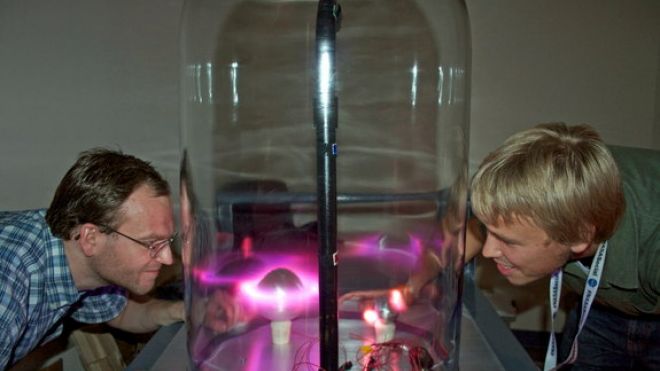- Web
- Humsa
- Videos
- Forum
- Q2A



Astronomers have found a mini planet beyond our solar system that is the smallest of more than 800 extra-solar planets discovered, scientists said on Wednesday.
The planet, known as Kepler-37b, is one of three circling a yellow star similar to the sun that is located in the constellation Lyra, about 210 light years away. One light year is about 6 trillion miles (10 trillion km)."We see very large planets and they're uncommon. Earth-sized planets seen to be pretty common, so our guess is that small planets must be even more common," said Thomas Barclay, with NASA's Ames Research Center in Mountain View, California.
The smaller the planet, the more difficult it is to find.Kepler-37b, as well as two sibling planets, were discovered with a NASA space telescope of the same name, which studies light from about 150,000 sun-like stars.The Kepler telescope works by detecting slight dips in the amount of light coming from target stars caused by orbiting planets passing by, or transiting, relative to the observatory's line of sight. The smaller the planet, the less pronounced the dip.
Of the 833 confirmed planets found beyond the solar system, 114 were discovered by the Kepler science team, according to the project's website. Nearly 3,000 more Kepler candidate planets are being analyzed.Planets located in "habitable zones" around their host stars, where water can exist on their surfaces, are of particular interest. Water is believed to be necessary for life.
A planet positioned about where Earth orbits the sun would take a year to fly around its parent star. At least two, and preferably three or more, orbits are needed to confirm that a transit spotted by the Kepler telescope is indeed a planet and not a star flare or some other phenomenon.Kepler-37b flies about 10 times closer to its star than Earth circles the sun, which gives it a surface temperature of about 800 degrees Fahrenheit (427 degrees Celsius).
This particular one is nowhere near habitable," University of Florida astronomer Eric Ford said.Mercury is the closet planet to the sun in our solar system, so scientists compared Kepler-37b to a mini Mercury.The little planet, which is slightly larger than Earth's moon, has two somewhat larger siblings. Kepler-37c, which is slightly smaller than Venus, circles the trio's parent star in 21 days and Kepler-37d, abouttwice the size of Earth, orbits in 40 days.
The whole system would fit within the orbit of Mercury, which circles the sun in 88 days."When we first found exo-planets, they were all much larger than anything we have in the inner solar system. We didn't know of anything that was smaller. This is the first time we've been able to probe the smallest range, smaller than anything we have in our solar system," Barclay said.The research was published in this week's Nature.
 THESE beautiful ice sculptures create a real winter wonderland as they are painstakingly created from huge mounds of compressed snow for China’s annual ice festival.
After thousands of man hours in the making, the stunning sculptures are finally ready for the throngs of tourists at the annual Jingyue Snow World festival in Jingyuetan National..... Read more
THESE beautiful ice sculptures create a real winter wonderland as they are painstakingly created from huge mounds of compressed snow for China’s annual ice festival.
After thousands of man hours in the making, the stunning sculptures are finally ready for the throngs of tourists at the annual Jingyue Snow World festival in Jingyuetan National..... Read more
 The passcode lock on the iPhone 5 isn't perfect, it seems.
A video posted on YouTube Jan. 31 by user shows how to bypass the lock on an iPhone 5 running iOS 6.1.The method was confirmed by the tech blog The Verge, which posted its own video showing the trick.Basically, as described by videodebarraquito on his YouTube page, the method involves going ..... Read more
The passcode lock on the iPhone 5 isn't perfect, it seems.
A video posted on YouTube Jan. 31 by user shows how to bypass the lock on an iPhone 5 running iOS 6.1.The method was confirmed by the tech blog The Verge, which posted its own video showing the trick.Basically, as described by videodebarraquito on his YouTube page, the method involves going ..... Read more
 The glowing colors and dancing lines of the Northern Lights could soon appear inside an educational institution near you.
A small device called Planeterrella bottles all the ingredients needed for the naturally occurring lights show — a magnetic field, a sphere and charged particles — and creates a mini version of the auroras inside.
The con..... Read more
The glowing colors and dancing lines of the Northern Lights could soon appear inside an educational institution near you.
A small device called Planeterrella bottles all the ingredients needed for the naturally occurring lights show — a magnetic field, a sphere and charged particles — and creates a mini version of the auroras inside.
The con..... Read more












 Clean Chit (Faisal Raza Abidi ...
Clean Chit (Faisal Raza Abidi ...  Akhir Kiyon - 16th December 2...
Akhir Kiyon - 16th December 2...  To The Point - 16th December ...
To The Point - 16th December ...  Capital Talk â
Capital Talk â  Kal Tak - 16th December 2013
Kal Tak - 16th December 2013  Bay Laag - 16th December 2013
Bay Laag - 16th December 2013  Kharra Sach - 16th December 2...
Kharra Sach - 16th December 2...  Awaam - 15th December 2013
Awaam - 15th December 2013 





 Gold Miner
Gold Miner  Superbike GP
Superbike GP  Whipsaw Fighter
Whipsaw Fighter  PacMan
PacMan 


